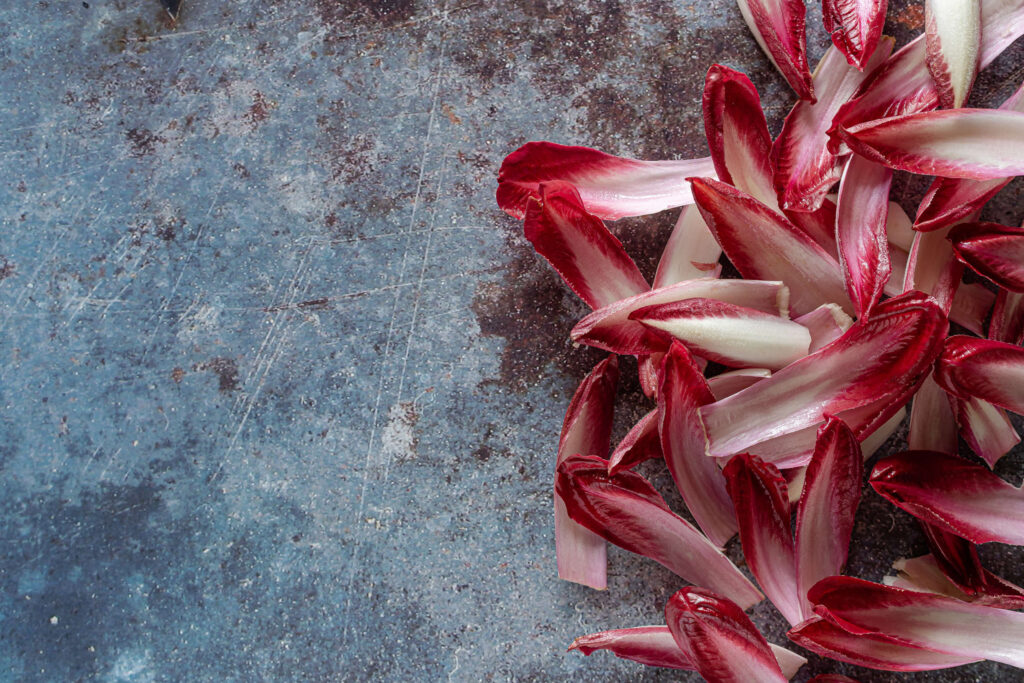
Endive is often mistaken for lettuce, when in fact it belongs to the daisy family. However, it is a green leafy vegetable that is often used in salads like mesclun (a mixture of young tender greens, usually includes arugula, chervil and endive) or cooked like spinach.
Endive is bitter tasting, and remember bitters are always good for the liver, and it has a load of nutrients including:
- Calcium
- Potassium : plays an important role in healthy functioning nerves, muscles, kidney, and heart. Increasing potassium intact can help lower your blood pressure and reduce your risk of heart disease and stroke.
- Vitamin A
- Vitamin B9 aka folate : helps your body make new red blood cells. You can get folate from the foods you eat or as a vitamin. The man-made form is known as folic acid.
- Pregnant women take folate supplements to protect against serious birth defects.
- Those who take folate reduce blood pressure and lower their risk of strokes.
- Vitamin K
- Fibre : athough endive is about 95% water, it is high in fiber which helps regulate blood glucose levels and regulates stool transit. Fiber also supports and transports good bacteria; helps reduce weight; and provides the compound that glutahtione attaches to when it takes toxins out of the body.
- Phytonutrients: powerful flavonoid found in endive is Kaempferol. Studies show that kaempferol-rich foods may be linked to a lower risk of developing certain cancers, such as colon, liver, and skin.
- Kaempferol is also an antioxidant; anti-inflammatory, and antimicrobial. Some say it may also offer protection against heart disease and diabetes.
Two varieties of endive are grown:
- Curly endive or frisée (var. crispum), which has narrow, curled, frilly leaves that are dark green
- Escarole (var. latifolium), which has smooth, broad leaves and a yellow center. Escarole is less bitter than curly endive.
Note that there is a general rule of thumb: the darker the leaf, the more nutrients. For instance, endive has more beta carotenes that your body converts to Vitamin A, than iceberg lettuce.
Endive is recognized medicinally for its ability to support digestion, skin, bone strength, liver function, and weight loss (due to the fiber content and low calories).
Growing Endive
Endive is considered a winter vegetable. In the northern hemisphere, endive is at its peak from October to April. More recently, they’ve been sold in spring and summer as well.
When picking endive, check that the leaves are crisp and bright green. They should be clean and free of brown spots. Go for young, tender leaves.
Place your salad greens in a bag and refrigerate at 35 degrees Fahrenheit to 40 degrees Fahrenheit. Just before using them, wash thoroughly under running water. Use a salad spinner or blot dry with paper towels.
How to Cook Endive
Try adding endive to your salad. Build a different salad by mixing up a few different types of greens:
- Mild lettuces like butterhead
- Crisp leaves like cabbage or romaine lettuce
- Those that have some bite, like endive or arugula
Adding a small amount of fat to your salad can help your body absorb nutrients better. Choose a dressing made with oil, such as a vinaigrette. This is a healthier choice than creamy dressings.
You can also cook endive. Sauté the leaves in some oil and season with a little salt and pepper and garlic. Greens will shrink while cooking, so be aware of portion sizes.
Endive can also be added to stews, soups, and casseroles. Add them toward the end.
You can replace crackers with Belgian endive and eat it with your favorite dip, chicken salad, or tuna salad.
Belgian endive is also great on your grill or roasted in the oven. Add some olive oil, balsamic vinegar, salt, and pepper for a tasty side dish.
To reduce the bitterness of Belgian endive, remove the small dense cone at the base of the core. Don’t soak the leaves, as that will make them more bitter. Instead, just rinse them quickly.
